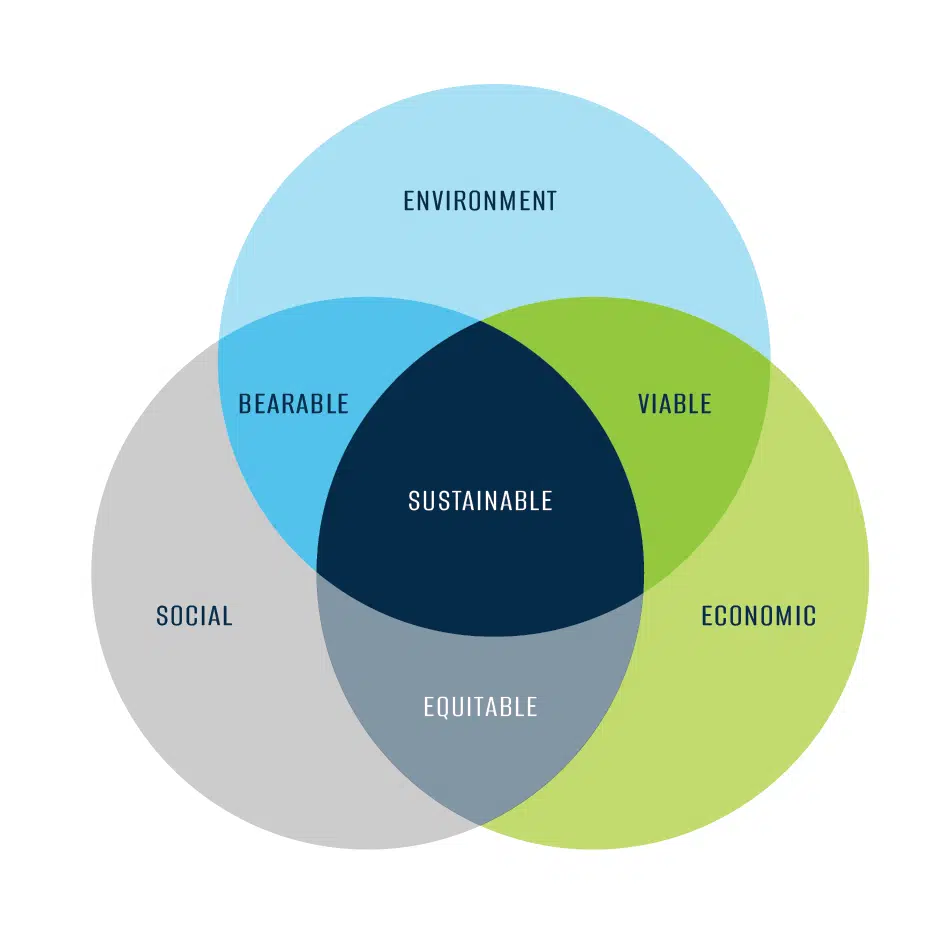What is Sustainability?

People frequently speak about the word “sustainability.” In the last few years, it’s become an increasingly referred to and adopted concept we hear from politicians, influencers, business leaders, scientists, and even friends and family. But what does it really mean? Is it a real, practical goal and if so, how do we get there? Today we’re going to dive into the idea of sustainability and look at how AYRO is leading the way.
Definition of Sustainability
To sustain means to keep something going with strength and support… simple enough. But in our frame of reference, what are we sustaining? Put simply, the Earth and each other. Finding ways to lessen or even eliminate our impact on the environment and co-exist with each other over a long period of time, is what sustainability is all about. At AYRO, we believe in what we refer to as a “comprehensive” view of sustainability which we’ll discuss further at the end of our article.
Why is Sustainability Important?
According to the UN, over the next 30 years, the world’s population is expected to increase by nearly 2 billion people. With such rapid growth and limited resources, the importance of sustainability is only increasing. Without a healthy environment, safe and supportive communities, and a way to ensure progress and prosperity, humanity will not be able to sustain itself for much longer. Growing recognition of these challenges is why the prioritization of sustainable concepts and practices is becoming an increasingly significant part of crucial conversations. Incorporating sustainable ideas into our world can, and should, be a priority. The Economic and Social Council for the United Nations has defined 3 pillars of sustainability that are at the core of the world’s efforts in sustainability.
The Three Pillars of Sustainability
The Three Pillars of Sustainability are economic sustainability, social sustainability, and environmental sustainability. As a triad of columns that jointly support a larger weight, overall success and achievability depend on each of the pillars working together in a complimentary fashion. While most people tend to think of and focus on the environmental sustainability pillar, all aspects of sustainability are equally important. If any one of the pillars begins to weaken, or even dominate, the balance necessary to achieve sustainability becomes threatened.
Economic Sustainability
Economic Sustainability is focused on creating practices that support long-term economic growth while limiting the impact on other elements in society including the environment and culture. Responsible businesses, understand that balancing investment, income, efficiency, and worker satisfaction are the keys to sustainability on all levels. There are many ways that businesses and workers can contribute to sustainability: businesses can be willing to focus initial capital investments on tools, methods, and materials that are socially and economically viable and ethical. For industry and manufacturing, this means reducing waste and a focus on renewable energy and materials. In agriculture, responsible land use, environmentally beneficial crops, and impact-neutral (or better) fertilizers and chemicals can not only increase crop yields but ensure that the productivity of a particular piece of land does not decrease over time. Responsible and supportive practices in terms of workforce integration and relations are important as well, which leads us to the next category.
Social Sustainability
Social Sustainability is about managing the impacts of systems, processes, organizations, and activities on people and social life. After all, the true end goal of sustainability is to ensure that there is a planet to support a healthy and prosperous society in the long term. In the distant past, sometimes simple survival was good enough to be considered “sustainable;” in today’s world, however, just being alive isn’t enough. With the advances that have been made in global societies, we have decided that quality of life is a crucial part of social sustainability. Social sustainability is perhaps the hardest to define and quantify because the components of quality of life are so varied. Access to health care, human and civil rights, financial stability, community development and improvement, social and political opportunity and responsibility are all aspects and expectations of a happy life. Ensuring that these needs are fulfilled for everyone is a big part of social sustainability.
Environmental Sustainability
Environmental Sustainability is the ability to create and maintain the conditions under which nature can exist in productive harmony to support present and future generations. This means we must develop and adopt ways to achieve an ecological balance in our planet’s environment, including responsible use and conservation of natural resources. The planet is a big place, though, and the dangers and challenges of increased populations and overuse of natural resources can make environmental balance difficult to achieve.
There is a lot of overlap between these areas, in what they seek to achieve, and how they seek to achieve it. It takes a global approach to consider all aspects equally, but the future of the planet is reliant upon the widespread adoption of these concepts and practices. Fortunately, there are ways that businesses and individuals can contribute.
Examples of Sustainability
The most effective examples of sustainability combine the attributes of all three pillars. Businesses, whether industrial, service, or agricultural can adopt practices that utilize all three pillars and make a big impact. For instance, building new factories to low- or zero-emission standards or retrofitting old factories to similar standards can be expensive but impactful. This allows for economic sustainability by limiting emissions or using existing properties, social sustainability by allowing individuals to use their creativity in innovative ways, and environmental sustainability through emission reduction. Even reducing, reusing, or recycling materials on an industrial or even personal level can make a huge difference in resource access and availability. Creating supportive work and community environments through fairness, free expression, and open opportunity can increase the willingness of workers and citizens to participate more fully in work, civic duty, and play. Each of these simple ideas can lead to small steps toward comprehensive sustainability.
Individuals can make purchasing choices based on the sustainability practices of merchants and manufacturers. Additionally, taking steps to maximize the energy efficiency of family homes and ensuring that construction and maintenance methods are environmentally responsible not only leads to financial savings but, with widespread participation, creates a wellspring of sustainability support. Even spending more time outside walking, exercising, or just being lazy means you’ll become more invested in nature!
There’s almost no end to the big and small things we can do in our society to increase sustainability, but not all of them are easy, cheap, or quick. This has led to strong disagreement and controversy on how to achieve a sustainable future.
Challenges to Achieving Sustainability
As stated earlier, the planet is a big place, and these efforts in sustainability and environmental balance are difficult to achieve. Many of the current and proposed solutions receive a great deal of resistance because they would require significant and fundamental changes in how our societies, economies, our communities are built and operate. Will we need to reorganize our living conditions for individual homes, and even for how our towns and cities operate? Will economic sectors be required to fundamentally change, or even be phased out? And on a personal level, are we as individuals willing to adjust our individual lifestyles that conserve energy, natural resources, and environmental impact? These questions, and attempts to answer them, lead to a great deal of lack of private and public participation. Few businesses are willing to invest in expensive systems that are more environmentally sustainable or curtail practices and products that might not initially be as profitable as less-sustainable but more lucrative alternatives. Changing personal habits is easier said than done, even with stakes as high as the future of the planet and the survivability of future generations.
Such reluctance from private businesses and individuals means that many sustainability champions have turned to governments to take leadership in developing processes, legislation, and regulations to encourage and, when necessary, enforce sustainability. This is actively occurring in governmental policy as legislators work to make eco-friendly options more affordable and reward sustainable choices through tax cuts and subsidies. However, until education, technology, and awareness enable a critical mass of economic viability, individual flexibility, and political majorities, sustainability will rely on the initiative of visionary leadership.
A Comprehensive View of Sustainability
We at AYRO believe in what we refer to as a “comprehensive view” of sustainability. As discussed throughout this post, sustainability is a journey that is constantly evolving. In our view, products across our industry are prematurely scrapped or built for planned obsolescence. This creates more waste than necessary.
Sustainable Products
AYRO products, including the AYRO Vanish, are built to be sustainable. With multiple configurations, the AYRO Vanish is built – not for planned obsolescence – but for adaptability. The vehicle is manufactured with a variety of sustainable products including bamboo and low-waste plastics. From tire tread, fuel cells, sound, and even discordant visuals, we apply engineering and artistry to every element of our product mix. This includes working to limit and eliminate production waste, developing products that last longer, and finding components and parts that are reusable creating less unnecessary scrap. Our goal is to continue to improve upon this design and other future designs to be as sustainable as possible – even to the point of not affecting the space in which our vehicles traverse or where our products are used.
A Traversed Space
At AYRO, we, along with other companies, are working to create shared value. Environmentally, we are not just about limiting our footprint but removing our footprint altogether. The 2023 AYRO Vanish is an example of these efforts with its soft tires that can erase their own footprint and other technologies that limit the disruption to the vehicle’s environment. These technologies are all developed through what we refer to as the SchlägerNull™ approach. We at AYRO are working to consider all aspects of sustainability, not just those in the creation, production, and delivery of the products we develop. This includes surface alteration, environmental or by-product residuals, sound, thermal hotspots, and even visual blending.
Sustainable Development
At AYRO, we believe that product design, production, corporate oversight and employee satisfaction all should be planned and managed with sustainability at its core. Driven by insight gained from partners, customers, and research, AYRO delivers a highly adaptable solution that empowers organizations to enable sustainable fleets. These purpose-built innovative and highly customizable low-speed electric vehicles (LSEVs) support a plurality of last-mile delivery, micro-distribution, and campus/facility mobility needs.
With a focus on sustainability, impact-limiting products, and sustainable development, AYRO hopes to be a leader in creating completely sustainable products and vehicles. This comprehensive view of sustainability is what AYRO believes can move both our company and society forward to reach the destination of sustainability ahead of us.


